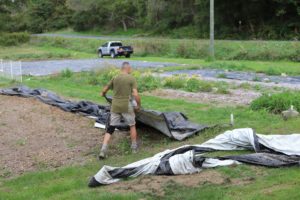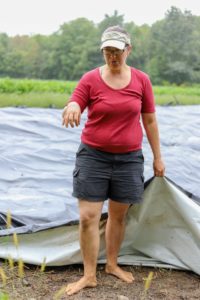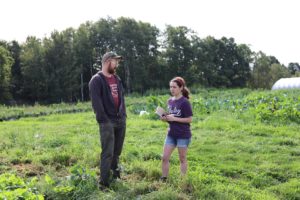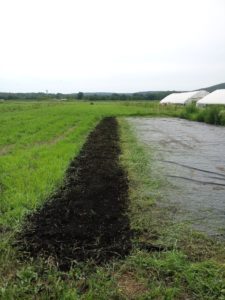Tarping: Combining Freeville Research with Local Farm Experience
Researchers working on reduced tillage take opaque tarps, simple and affordable tools with the potential to reduce tillage, to farms in the Finger Lakes Region and Hudson Valley to test their usability on real farms.
The Cornell Small Farms Program is working to find effective ways to reduce tillage on small farms throughout New York State through the Reduced Tillage project. Based at the Homer C. Thompson Research Farm in Freeville, NY, Small Farms Program staff Ryan Maher and Brian Caldwell have spearheaded the project for four years.
Tackling reduced tillage means finding alternative strategies to manage weeds. Weeds are problematic for small and large farms alike. Tillage can be an effective strategy for elimination of weeds, but can also damage soil health. Frequent and deep tillage can degrade soil structure over time, decreasing soil organic matter and moisture content and increasing erosion.
A strategy to combat weeds while maintaining soil health is using tarps. Tarping has become increasingly popular among small-scale farmers and can be used for a period of a few weeks in the spring to prepare a seedbed for planting, several months over-winter, or intermittently in the growing season. An article in the Spring 2018 Quarterly synthesized many benefits of tarping after several years of trials in Freeville.
Tarp Trials in Freeville, Local Farms
Over the past two years research trials in Freeville, NY, as well as in Long Island and Maine, have looked into the impact of tarps on the soil, weed pressure, and yield of direct-seeded beets. While crop and weed residue were not degraded by tarps in these experiments, soil nitrate concentrations increased significantly, and there were no living weeds present under tarps of any duration. Tarped plots kept lower weed pressure for two weeks, and at the end of the season, tarped plots had almost no perceptible difference between tillage treatments for beet yield or weed pressure, whereas untarped plots had significant differences between tillage treatments.
These trials with beets show benefits of tarp use, but are these results generalizable to working farms? Cornell University master’s student, Haley Rylander, partnered with small farms throughout New York State to observe the functionality of tarp use.
Haley worked with several farms in the Finger Lakes region, and found positive results and feedback from area farmers. The incorporation of tarping into their farming systems was a learning curve, but the local farmers found weed suppression and better regulated soil moisture as benefits making tarp use worthwhile.
Centurion Farm

Jeff Saeli (Centurion Farm) lays tarps on the soil in the fall to protect the soil and preserve his planting bed over the winter.
Kacey Deamer / Cornell Small Farms Program
Locke, NY is home to Centurion Farm owned by Nina and Jeff Saeli. The Saelis had not used tarps previously, but found increased soil moisture in tarped beds compared with bare soil, and some reduction in weed pressure.
They planted two crops to compare the impact of tarp use: dry beans and onions. The onion beds were prepared the previous fall, tarped for 3-4 weeks in spring, and then planted into (without further bed preparation) as soon as the tarps were removed. Since onions were planted early, the tarps went on early. Therefore, the ground underneath the tarp did not heat up as much as other trials.
Tarps were applied later for the dry beans. The difference in soil moisture between tarped and untarped beds was more noticeable in the bean plots. In addition to soil moisture, Nina and Jeff found that the untarped bean plots had significantly more weeds.
“Even though it hasn’t shown to be successful to help us reduce our tillage because it’s too early, I can tell you that the weed suppression alone makes the tarp worth it,” Nina said. “When I timed myself when I weeded, on the tarped beans, it literally took me more time to walk the beds to look for weeds than it took me to actually weed. And if there was a weed, it was something that just got snapped up easy with a linear hoe.”
Nina and Jeff said they will be using tarps next growing season. They hope to be able to reduce tillage as they create systems with tarp use. A strategy they have for managing the heavy tarps is to cut their 50’x40’ tarps in half to make folding and handling of the tarps easier.
Muddy Fingers Farm

Liz Martin (Muddy Fingers Farm) lifts a tarp to show how tarps preserve moisture in the soil and kill weeds by cutting off light.
Kacey Deamer / Cornell Small Farms Program
Liz Martin and Matthew Glenn own Muddy Fingers Farm in Hector, NY. They tarped their beds 4-5 weeks before planting beets and found that the tarps retained soil moisture better on their farm as well. Their tarped and untarped beds received the same amount of water throughout the season, yet the plants in the tarped beds had much better stand counts.
Tarps were also useful for weed suppression. The beds were tilled before placing the tarps, and the ground had green weeds. When tarps were removed before planting, everything was dead leaving a fresh bed for planting.
Liz and Matthew use cover crops on their farm and have found that tarps can sometimes be used in place of a cover crop, or used to kill a cover crop before planting. They already try to reduce tillage, but have found that these methods help in reducing tillage within their system.
From a soil health standpoint, Liz recommends tarping. She says that tarping opens up options for farmers by bringing up earthworms and nutrients. While suggesting that everyone tries it if even only considering tarping, Liz cautions that planning ahead is crucial. Successfully implementing tarps requires that your planting schedule fits with a 4- to 6-week window of tarps being down.
Plowbreak Farm

Haley Rylander talks to Aaron Munzer (Plowbreak Farm) about his experience using tarps to effectively suppress perennial weeds, such as quackgrass, for a crop of mixed greens. Kacey Deamer / Cornell Small Farms Program
Perennial weed suppression has been a benefit of using tarps for Aaron Munzer and Cara Cusolito of Plowbreak Farm in Hector, NY. In their second year of using tarps, they said it’s better than any other tillage or control methods that they’ve tested for perennial control. For Aaron and Cara, tarping has been especially helpful in establishing a new farm by combatting thistle and quackgrass.
Aaron and Cara prep their seedbeds before laying down the tarps, then plant directly into the beds after tarp removal. Although not a perfect solution, Aaron said tarping “does really wipe out the majority of the seed bank in the top strata of the soil.” Soil moisture was retained under their tarps, and soil life seemed undisturbed. Worms and bugs were able to survive while any living plant material under the tarp was killed.
Similar to Muddy Fingers Farm, Aaron states that tarping doesn’t add to the flexibility of his farm and requires planning. When not in use, tarps are rolled up on the edge of beds. Tarps are no silver bullet, but Aaron said tarping is “a tool in our tool belt of options to keep weeds down and to practice some reduced tillage.”
Rise and Root Farm

Weed pressure was so strong at Rise and Root Farm in the Hudson Valley, they had to weed whack around their beds, but a rolled-back tarp shows bare soil ready to plant in.
Jane Hodge / Rise and Root Farm
Tarps aren’t a new sight on the black dirt of Rise and Root Farm, but Jane Hodge, Karen Washington, and Michaela Hayes continue to reap the benefits of tarps on their Hudson Valley farm. They laid tarps for 3.5 weeks prior to planting dill, cilantro, and Thai basil. The tarped beds required no early-season weeding in comparison to the untarped beds, which required 2 hours of hand-weeding. Jane, Karen, and Michaela tilled before tarp application and used a broadfork after tarp removal to loosen soil due to severe compaction from earlier in the season.
Jane said the contrast between the soil under the tarps and the surrounding ground was striking.
“The bed underneath was weed free and ready to plant,” she said. “We actually had to weed whack around the bed because the surrounding weeds had gotten so out of control.
The trials in Freeville combined with area farms found increased soil moisture, elevated nitrate levels, weed suppression, and the ability to reduce tillage as benefits of adding tarping to your system.
For more information, contact Haley at hrr53@cornell.edu or visit the project website at www.smallfarms.cornell.edu/projects/reduced-tillage/


Wondering if any research is being done on the possibility of phthalate residues in soils & crops in tarped fields. I love the weed elimination, but worry about leaving toxic substances in the soil on my organic farm.
The successful implementation of tarping across various farms underscores its potential as a valuable tool for reducing tillage and improving soil health. These firsthand accounts provide valuable insights for farmers seeking practical strategies to enhance their agricultural practices.
Kitchen Remodeling Services in Orlando FL